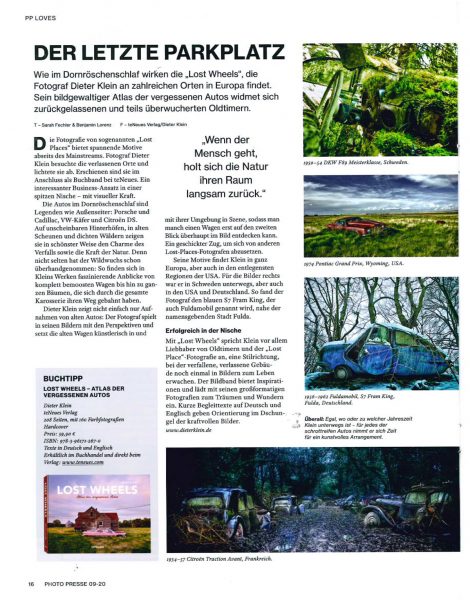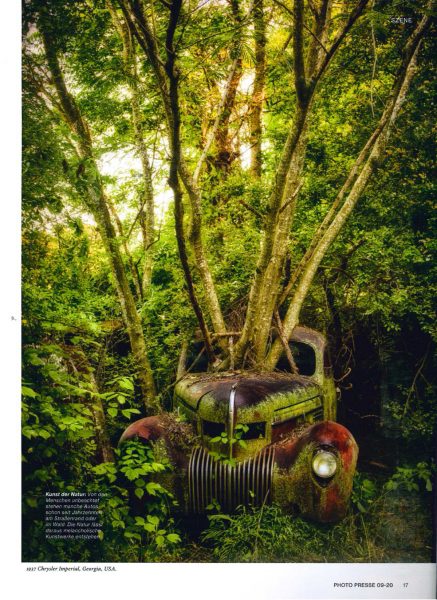DER LETZTE PARKPLATZ
Wie im Dornröschenschlaf wirken die „Lost Wheels“, die Fotograf Dieter Klein an zahlreichen Orten in Europa findet. Sein bildgewaltiger Atlas der vergessenen Autos widmet sich zuruckgelassenen and teils überwucherten Oldtimern.
Die Fotografie von sogenannten „Lost Places“ bietet spannende Motive abseits des Mainstreams. Fotograf Dieter Klein besuchte die verlassenen Orte und lichtete sie ab. Erschienen sind sie im Anschluss als Buchband bei teNeues. Ein interessanter Business-Ansatz in einer spitzen Nische – mit visueller Kraft. Die Autos im Dornröschenschlaf sind Legenden wie Außenseiter: Porsche und Cadillac, VW-Kafer und Citroen DS. Auf unscheinbaren Hinterhöfen, in alten Scheunen und dichten Wäldern zeigen sie in schönster Weise den Charme des Verfalls sowie die Kraft der Natur. Denn nicht selten hat der Wildwuchs schon überhandgenommen: So finden sich in Kleins Werken faszinierende Anblicke von komplett bemoosten Wagen bis hin zu ganzen Bäimen, die sich durch die gesamte Karosserie ihren Weg gebahnt haben. Dieter Klein zeigt nicht einfach nur Aufnahmen von alten Autos: Der Fotograf spielt in seinen Bildern mit den Perspektiven und setzt die alten Wagen künstlerisch in und
„Wenn der Mensch geht, holt sich die Natur ihren Raum Iangsam zuruck.”
mit ihrer Umgebung in Szene, sodass man manch einen Wagen erst auf den zweiten Blick überhaupt im Bild entdecken kann. Ein geschickter Zug, um sich von anderen Lost-Places-Fotografen abzusetzen. Seine Motive finder Klein in ganz Europa, aber auch in den entlegensten Regionen der USA. Für die Bilder rechts war er in Schweden unterwegs, aber auch in den USA und Deutschland. So fand der Fotograf den blauen S7 Frain King, der auch Fuldamobil genannt wird, nahe der namensgebenden Stadt Fulda.
Erfolgreich in der Nische
Mit „Lost Wheels“ spricht Klein vor allem Liebhaber von Oldtimem und der „Lost Place“-Fotografie an, eine Stilrichtung, bei der verfallene, verlassene Gebäude noch einmal in Bildern zum Leben erwachen. Der Bildband bietet Inspirationen und lädt mit seinen großformatigen Fotografien zum Träumen und Wundern ein. Kurze Begleittexte auf Deutsch und Englisch geben Orientierung im Dschungel der kraftvollen Bilder.
-.-
THE LAST PARKING SPACE
The „Lost Wheels“ that photographer Dieter Klein finds in numerous places in Europe appear to be in a deep sleep. His visually stunning Atlas of Forgotten Cars is dedicated to abandoned and partly overgrown classic cars.
The photography of so-called „Lost Places“ offers exciting motifs away from the mainstream. Photographer Dieter Klein visited the abandoned places and photographed them. They were subsequently published as a book volume by teNeues. An interesting business approach in a sharp niche – with visual power. The cars in Sleeping Beauty are legends as well as outsiders: Porsche and Cadillac, VW-Kafer and Citroen DS. In inconspicuous backyards, old barns and dense forests, they beautifully display the charm of decay as well as the power of nature. For it is not uncommon for the wild growth to have already taken over: Thus, fascinating sights of completely mossy cars to entire trees that have made their way through the entire body can be found in Klein’s works. Dieter Klein doesn’t just show shots of old cars: the photographer plays with perspectives in his pictures and artistically sets the old cars in and
„When man leaves, nature slowly reclaims its space.“
with their surroundings, so that some cars can only be discovered in the picture at second glance. A clever move to set himself apart from other lost places photographers. Klein finds his motifs all over Europe, but also in the remotest regions of the USA. For the pictures on the right, he traveled to Sweden, but also to the U.S. and Germany. That’s how the photographer found the blue S7 Frain King, also known as the Fuldamobil, near the city that gives it its name, Fulda.
Successful in the niche
With „Lost Wheels,“ Klein primarily appeals to lovers of classic cars and „lost place“ photography, a style in which dilapidated, abandoned buildings once again come to life in pictures. The illustrated book offers inspiration and, with its large-format photographs, invites readers to dream and wonder. Short accompanying texts in German and English provide orientation in the jungle of powerful images.


